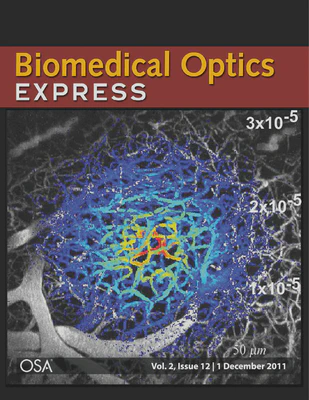Abstract
In vivo surface imaging of fluorescently labeled vasculature has become a widely used tool for functional brain imaging studies. Techniques such as phosphorescence quenching for oxygen tension measurements and indocyanine green fluorescence for vessel perfusion monitoring rely on surface measurements of vascular fluorescence. However, the depth dependence of the measured fluorescence signals has not been modeled in great detail. In this paper, we investigate the depth dependence of the measured signals using a three-dimensional Monte Carlo model combined with high resolution vascular anatomy. We found that a bulk-vascularization assumption to modeling the depth dependence of the signal does not provide an accurate picture of penetration depth of the collected fluorescence signal in most cases. Instead the physical distribution of microvasculature, the degree of absorption difference between extravascular and intravascular space, and the overall difference in absorption at the excitation and emission wavelengths must be taken into account to determine the depth penetration of the fluorescence signal. Additionally, we found that using targeted illumination can provide for superior surface vessel sensitivity over wide-field illumination, with small area detection offering an even greater amount of sensitivity to surface vasculature. Depth sensitivity can be enhanced by either increasing the detector area or increasing the illumination area. Finally, we see that excitation wavelength and vessel size can affect intra-vessel sampling distribution, as well as the amount of signal that originates from inside the vessel under targeted illumination conditions.
